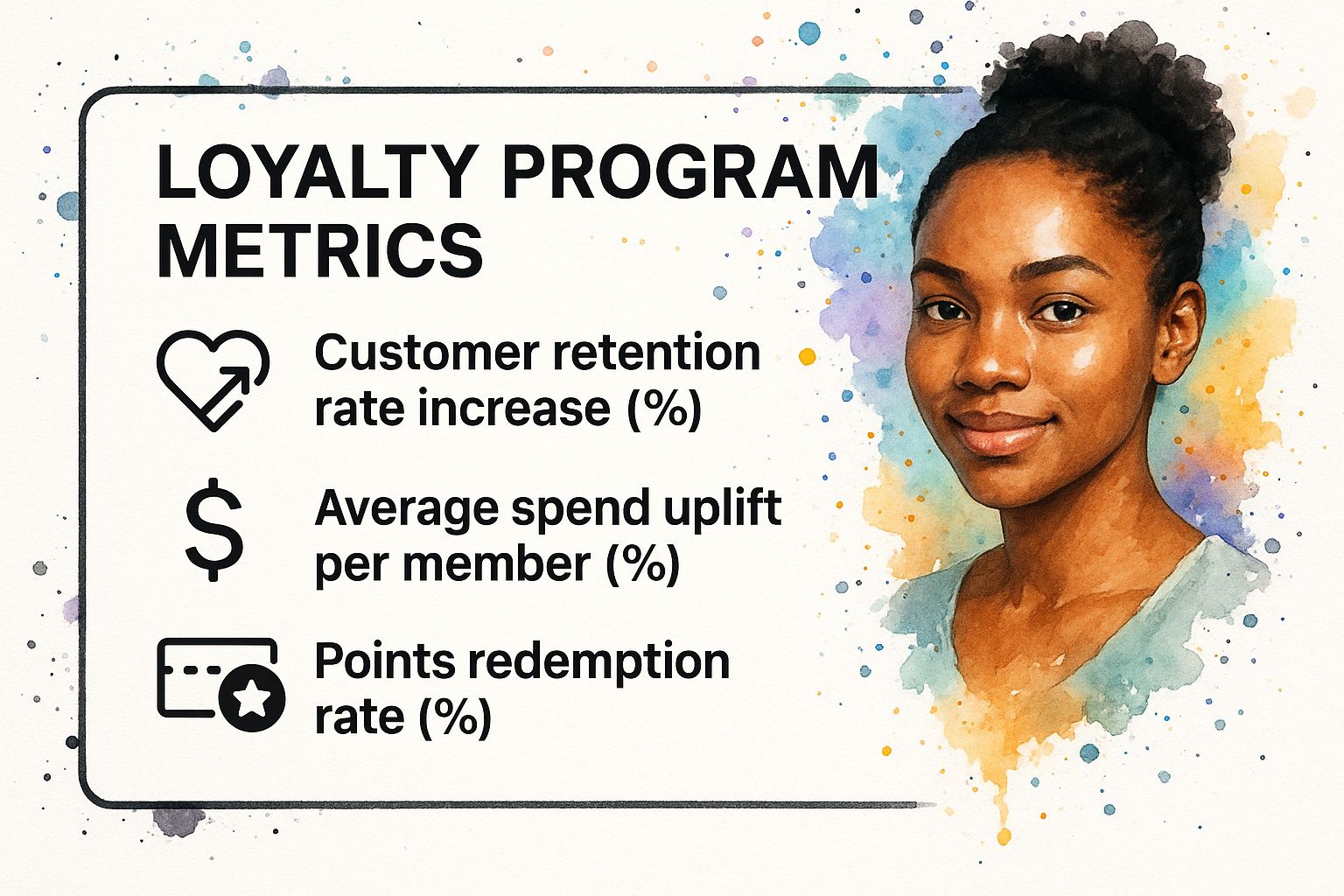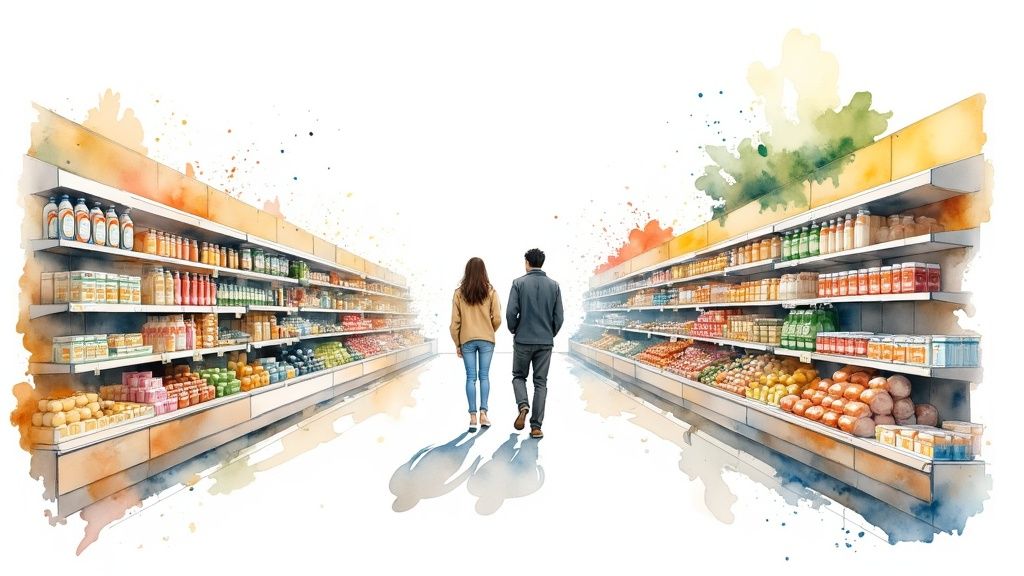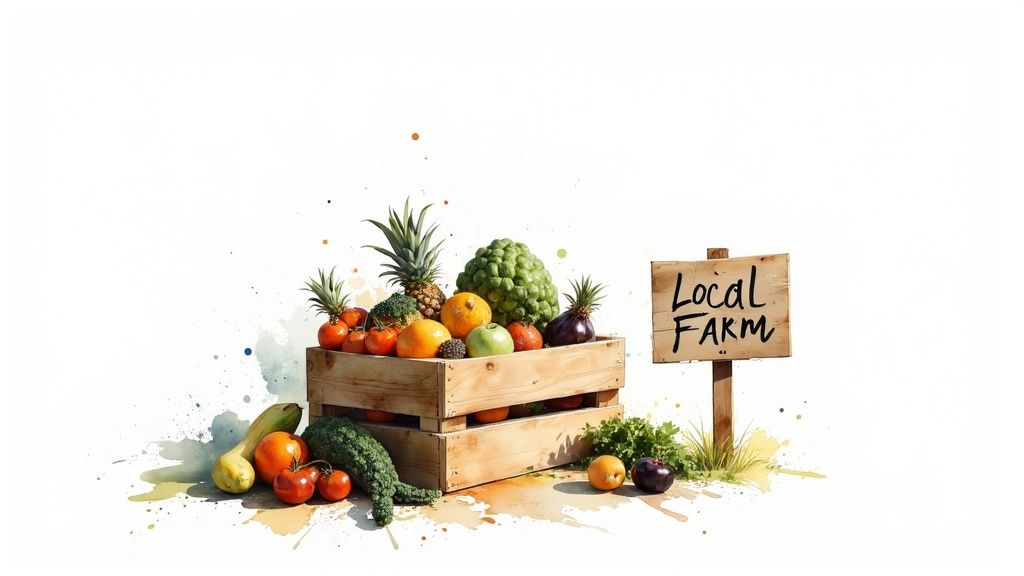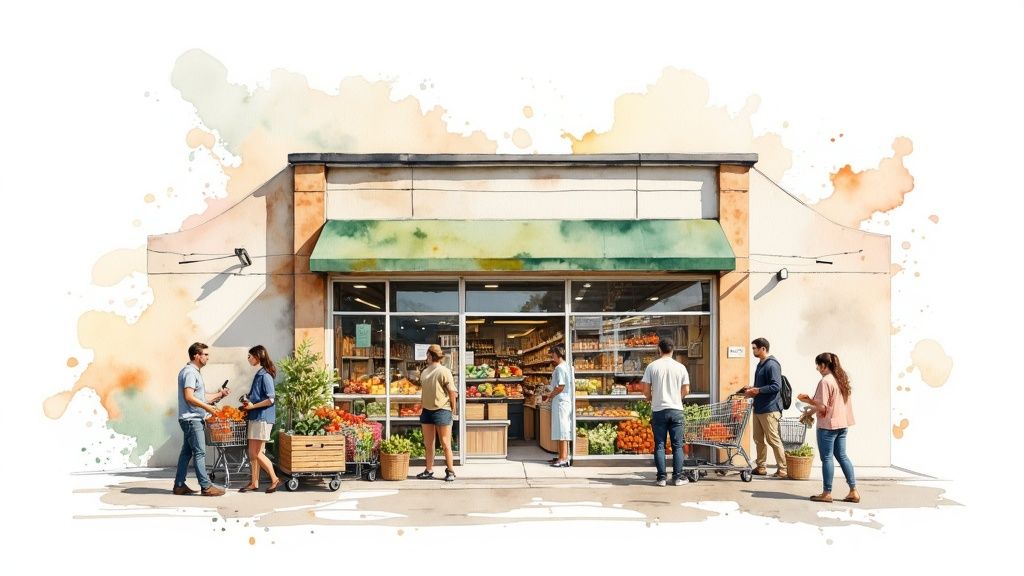Discover 10 actionable grocery store marketing strategies to boost foot traffic, loyalty, and sales. Drive growth with these proven tactics for 2025.
In This Article
Subscribe to our newsletter
The modern grocery landscape is more competitive than ever. Standing out requires more than just stocked shelves and weekly flyers; it demands a sophisticated, multi-channel approach to connect with today's savvy shoppers. Success is no longer measured solely by the number of transactions processed at checkout. Instead, it’s defined by the strength of the customer relationships you build and the loyalty you cultivate over time. Effective grocery store marketing strategies are the cornerstone of this new paradigm, blending digital innovation with timeless community-focused principles.
This comprehensive guide moves beyond generic advice to provide a clear, actionable roadmap. We will explore 10 powerful, data-driven strategies designed to transform your store into a community hub, drive sustainable growth, and secure customer loyalty. Forget surface-level tips; you'll gain practical insights into implementing everything from advanced loyalty programs and omnichannel shopping experiences to strategic local partnerships and private label development.
Each strategy is a critical building block for creating a resilient and profitable business that customers will choose time and time again. You will learn how to:
- Integrate digital tools like mobile apps and personalized analytics.
- Optimize your physical store layout for maximum sales impact.
- Leverage community engagement to build an unshakeable brand presence.
- Develop a pricing and product strategy that balances value and profitability.
Let's dive into the specific, actionable insights that will redefine how you market your grocery store and ensure it thrives in a crowded market.
1. Loyalty Programs and Rewards Systems
Loyalty programs are foundational grocery store marketing strategies designed to foster long-term customer relationships. Instead of one-off promotions, these structured systems reward shoppers for their repeat business, transforming casual visitors into a loyal customer base. The core mechanism involves offering tangible value-points for discounts, exclusive member-only pricing, or personalized deals-in exchange for consistent patronage and valuable shopping data. This creates a powerful, mutually beneficial cycle where customers feel appreciated and the store gains predictable revenue and deep insights into purchasing behavior.
How to Implement an Effective Loyalty Program
Successful loyalty systems, like Kroger's Plus Card with its fuel rewards or Safeway's "Just for U" personalized digital coupons, demonstrate that the key is tangible, easily understood value. For grocers just starting, a simple points-per-dollar-spent system is a great entry point. As your program matures, you can introduce tiered rewards, birthday specials, or exclusive access to new products.
Key steps for implementation include:
- Start Simple: Begin with a straightforward points-based or tiered discount system. Avoid overcomplicating the rules, which can deter enrollment.
- Integrate Technology: A dedicated mobile app is no longer a luxury; it's essential for modern loyalty programs. It allows customers to track points, clip digital coupons, and receive push notifications for personalized offers, creating a seamless user experience.
- Personalize the Experience: Leverage the data collected to offer deals that are genuinely relevant to each shopper. If a customer frequently buys organic produce, send them a coupon for a new organic snack brand. For specific insights tailored to the grocery sector, consider exploring the best loyalty programs for grocery stores to find a model that fits your business.
- Communicate Clearly: Use in-store signage, email newsletters, and app notifications to constantly remind customers of the program's benefits and how to use them.
Key Loyalty Program Metrics
The following summary box highlights the direct impact a well-executed loyalty program can have on key business metrics.

As the data shows, these programs directly influence customer retention and spending habits, proving they are a worthwhile investment for sustainable growth. Regularly analyzing this data and adjusting your rewards strategy is crucial for maximizing your return on investment.
2. Digital Coupons and Mobile App Integration
Digital coupons represent a fundamental shift from traditional paper circulars to dynamic, data-driven promotions. This strategy involves distributing discounts through mobile apps, websites, and email, allowing shoppers to digitally "clip" and redeem offers seamlessly at checkout. By integrating these coupons into a dedicated mobile app, grocery stores can provide a centralized hub for savings, shopping lists, and personalized deals. This approach not only enhances customer convenience but also equips retailers with invaluable analytics on coupon usage, redemption rates, and shopping habits, enabling highly targeted marketing efforts.
How to Implement Digital Coupons and an App Effectively
Leading grocers like Kroger, whose app has surpassed 500 million downloads, and Safeway, with its personalized "Just for U" platform, prove that success lies in a user-friendly and value-packed mobile experience. The key is to make finding and using coupons easier than the traditional method. For stores developing their digital presence, focusing on a clean interface and exclusive digital-only deals can drive initial adoption and engagement.
Key steps for implementation include:
- Prioritize User Experience (UX): Design an app interface that is intuitive and simple to navigate. Customers should be able to find, clip, and organize coupons with minimal effort. Features like a built-in barcode scanner for in-aisle price checks can add significant value.
- Offer Exclusive Digital Deals: Motivate customers to download and use your app by providing offers that are not available in print. These exclusive, high-value digital coupons create a compelling reason for shoppers to engage with your mobile platform.
- Utilize Push Notifications: Send timely, relevant push notifications to alert users about expiring coupons, new personalized deals based on their shopping history, or special in-store promotions. This keeps your store top-of-mind and drives repeat visits.
- Enable Offline Access: Ensure that clipped coupons are saved to the device and accessible even with poor or no internet connection inside the store. This small technical detail prevents a common point of customer frustration at checkout.
3. Local Community Engagement and Sponsorships
Local community engagement is a powerful grocery store marketing strategy that moves beyond transactional relationships to build deep, emotional connections. This approach involves actively participating in and supporting the neighborhood through sponsorships, event hosting, and partnerships with local organizations. By embedding the store within the fabric of the community, grocers demonstrate a genuine commitment to the area's well-being, fostering a powerful sense of goodwill and brand preference that price matching alone cannot achieve. This strategy transforms a store from just a place to buy food into a valued community partner.
How to Implement Effective Community Engagement
Brands like H-E-B, with its deep-rooted Texas community programs, and Publix, known for its consistent support of local schools, prove that sustained local involvement creates unshakable loyalty. The goal is to become an indispensable part of the neighborhood's identity.
Key steps for implementation include:
- Choose Aligned Causes: Select sponsorships that reflect your brand’s values. If your store emphasizes fresh, healthy living, sponsoring a youth sports team or a local 5K run is a natural fit.
- Empower Your Team: Encourage employees to act as community ambassadors. Offering paid volunteer time or organizing team participation in local charity events makes your store's presence feel more authentic and personal.
- Share Your Stories: Document and share your community involvement through social media, in-store signage, and email newsletters. Showcasing photos from a sponsored school event or a successful food drive makes your contributions visible and relatable to shoppers. For more inspiration on building a community-focused brand, review the IGA's Hometown Proud initiatives, which showcase a model of localized commitment.
- Prioritize Long-Term Partnerships: Instead of one-off donations, build lasting relationships with local schools, food banks, or community centers. Consistent, long-term support demonstrates genuine commitment and has a more significant impact over time.
4. Strategic Product Placement and Store Layout Optimization
Strategic product placement is a scientific approach to designing a grocery store's physical space to guide customer behavior, maximize sales, and improve the shopping experience. This grocery store marketing strategy leverages retail psychology and data analytics to transform a simple floor plan into a powerful sales tool. By carefully orchestrating where products are placed, how aisles are arranged, and what customers see first, stores can significantly increase basket sizes, drive impulse purchases, and create a more intuitive and enjoyable journey for every shopper.

How to Implement an Effective Store Layout
Leading grocers demonstrate the power of intentional design. Whole Foods places its vibrant produce section near the entrance to create an immediate impression of freshness and quality. Trader Joe's utilizes a compact, discovery-focused layout that encourages browsing, while Costco’s warehouse style and "treasure hunt" item placement drive bulk purchases and exploration.
Key steps for implementation include:
- Create a Powerful First Impression: Position high-margin, visually appealing departments like fresh produce, flowers, or the bakery near the store entrance. This sets a positive tone for the entire shopping trip.
- Optimize High-Traffic Areas: Use end caps and checkout aisles for high-impulse, seasonal, or promotional items. For inspiration on making these spaces work harder, review some creative end cap display ideas to capture customer attention effectively.
- Leverage Cross-Merchandising: Place complementary products together to increase the likelihood of add-on sales. Position tortilla chips next to the salsa and guacamole, or place wine and cheese pairings in the same display.
- Use Data to Guide Decisions: Analyze customer movement patterns, heat maps, and sales data to identify hot and cold zones in your store. Use these insights to reposition underperforming products or test new layouts.
Visualizing the Shopper's Journey
Understanding how customers navigate your store is crucial for layout optimization. The video below, from retail anthropologist Paco Underhill, offers fascinating insights into shopper behavior and the small environmental details that can have a massive impact on purchasing decisions.
By continuously refining your store's layout based on shopper psychology and hard data, you can create a seamless environment that not only meets customer needs but also strategically boosts your bottom line.
5. Fresh and Local Product Emphasis
Highlighting fresh, locally-sourced, and artisanal products is a powerful grocery store marketing strategy that builds a strong brand identity around quality, community, and authenticity. This approach moves beyond price competition by appealing to a growing consumer demand for transparency, health-conscious options, and supporting the local economy. By positioning your store as a hub for the best local goods, you create a unique selling proposition that larger, more generic chains struggle to replicate, fostering a deep sense of trust and connection with shoppers.

This strategy is about more than just stocking products; it's about storytelling and creating an experience. When customers know the farm their strawberries came from or the family behind their favorite artisanal cheese, the products gain intrinsic value. Grocers like H-E-B with its extensive "Primo Picks" and "Go Local" Texas producer network, or Whole Foods with its detailed local supplier profiles, have perfected this by making the producers the heroes of their marketing campaigns.
How to Implement a Local-First Strategy
Successfully emphasizing local products requires a genuine commitment to sourcing and promotion. It starts with building relationships with farmers, bakers, and artisans in your community. The goal is to make these items feel special and easily discoverable for your customers, turning a simple grocery trip into a celebration of local flavor.
Key steps for implementation include:
- Tell Their Story: Don't just sell a product; sell its origin. Use in-store signage, shelf talkers, and QR codes to share compelling stories about the local producers. Feature them on your website's blog or social media channels with interviews and behind-the-scenes photos.
- Use Clear "Local" Signage: Create a distinct and consistent visual identity for all locally-sourced items. Use special shelf tags, end-cap displays, or even a dedicated "Shop Local" aisle to make these products stand out and easy for shoppers to find.
- Host Tastings and Demonstrations: There's no better marketing than letting customers taste the quality for themselves. Schedule regular in-store sampling events featuring local vendors. This not only drives sales but also allows shoppers to meet the people behind the products, building a powerful personal connection.
- Create Seasonal Campaigns: Build marketing campaigns around seasonal availability. Promote "Peak Peach Season" or a "Fall Harvest Festival" featuring local squash, apples, and ciders. This creates urgency and excitement while educating customers on the benefits of eating seasonally.
6. Omnichannel Shopping Experience
An omnichannel shopping experience is one of the most critical grocery store marketing strategies in the modern retail landscape. It focuses on creating a seamless and integrated customer journey that connects online and offline channels. Instead of treating e-commerce and physical stores as separate entities, this approach unifies them, offering customers ultimate flexibility. Shoppers can browse online, add items to a cart via a mobile app, and choose between curbside pickup, home delivery, or completing their purchase in-store, all within a single, consistent brand ecosystem. This model meets customers wherever they are, providing convenience that builds profound loyalty and broadens a store's market reach.
How to Implement an Effective Omnichannel Strategy
Leading retailers like Walmart and Target have set the standard for omnichannel excellence. Walmart pioneered large-scale grocery pickup, while Target integrated its Shipt acquisition to offer rapid same-day delivery, demonstrating that success hinges on a flawless connection between digital platforms and physical store operations. This strategy is not just for giants; local grocers can also implement it effectively by starting small and scaling up.
Key steps for implementation include:
- Start with One Channel: Begin by offering a single, well-managed service, like "click-and-collect" (curbside pickup). Perfecting this one channel first builds operational confidence and a positive customer reputation before you expand into more complex services like home delivery.
- Invest in Robust Technology: A reliable e-commerce platform that syncs inventory in real-time between your online and in-store systems is non-negotiable. This prevents out-of-stock frustrations and ensures a smooth ordering process for the customer.
- Train Staff for New Roles: Your employees are central to making omnichannel work. Staff must be trained as personal shoppers, order assemblers, and customer service experts who can handle the nuances of fulfilling online orders quickly and accurately.
- Maintain Consistent Pricing: Ensure that prices and promotions are consistent across your website, mobile app, and physical store. Discrepancies can erode customer trust and create confusion, undermining the seamless experience you aim to provide.
- Focus on a Seamless Handoff: The final touchpoint, whether it’s a quick curbside delivery or a friendly in-store pickup, is crucial. Optimize the process to be fast and frictionless, reinforcing the convenience that drew the customer to your service.
7. Personalized Marketing and Data Analytics
Personalized marketing moves beyond generic promotions by using customer data and analytics to deliver highly relevant offers and experiences. This strategy leverages purchase history, browsing behavior, and loyalty program data to understand individual shopper preferences. Instead of a one-size-fits-all approach, grocers can send targeted coupons for a customer's favorite brand of yogurt or suggest a new product based on past purchases. This data-driven approach makes customers feel understood and valued, significantly boosting engagement, conversion rates, and overall basket size.
How to Implement Personalized Marketing
Industry leaders like Kroger, with its powerful 84.51° analytics division, and Tesco, with its long-standing Clubcard data insights, prove that deep personalization is a key differentiator. The goal is to make every interaction feel tailored to the individual. For a grocery store, this means transforming raw data into actionable marketing campaigns that resonate on a one-to-one level.
Key steps for implementation include:
- Start with Segmentation: Before diving into complex algorithms, begin by grouping customers into basic segments. Categories can include frequent organic shoppers, families with young children, or budget-conscious buyers. This allows for more targeted, relevant messaging than a single mass email.
- Leverage Technology and Ensure Privacy: Utilize a Customer Data Platform (CDP) to unify data from your POS system, loyalty app, and website. Crucially, always be transparent about data usage and prioritize security to maintain customer trust. Offering tangible value, like exclusive discounts, is key to encouraging data sharing.
- Test and Optimize: Use A/B testing for your personalized campaigns. Send one customer segment an offer for 20% off a product category and another a "buy one, get one free" deal to see which performs better. Continuously refine your approach based on these results.
- Integrate Recommendations: Implement a recommendation engine on your e-commerce site or mobile app. Suggest items that pair well with what's already in a customer's cart, such as suggesting fresh basil for a customer buying tomatoes and mozzarella. For more on this, you can explore how to transform your strategy with data-driven insights to enhance your marketing efforts.
8. Social Media Marketing and Influencer Partnerships
Social media marketing and influencer partnerships have become indispensable grocery store marketing strategies for building brand personality and community. Beyond simply advertising deals, these channels allow grocers to connect with shoppers on a more personal level by sharing compelling food-centric content, recipes, and user-generated stories. By leveraging platforms like Instagram, Facebook, and TikTok, stores can transform their brand from a place to buy ingredients into a source of culinary inspiration and a hub for local food lovers. Partnering with local food bloggers and community influencers adds a layer of authenticity, providing trusted, third-party endorsements that resonate deeply with target audiences.

How to Implement an Effective Social Media and Influencer Strategy
Success in this arena, as seen with Trader Joe's product-focused Instagram or H-E-B's regional Texas pride, comes from creating authentic, platform-native content. The goal is to build a community, not just an audience. For a deeper dive into optimizing your online presence and maximizing engagement, explore essential tips on effective social media marketing strategies.
Key steps for implementation include:
- Focus on Inspiration, Not Just Sales: Center your content around recipes, cooking tips, and beautiful food photography. Showcase how your products can be used to create delicious meals, inspiring followers to visit your store for the ingredients.
- Partner with Local Voices: Identify local food bloggers, chefs, or community leaders who align with your brand values. A partnership can range from sponsored posts featuring your products to collaborative in-store events or cooking demonstrations.
- Encourage User-Generated Content (UGC): Create a branded hashtag and encourage customers to share photos of the meals they create with your products. Featuring customer photos on your channels builds a strong sense of community and provides authentic social proof. To learn more about building a vibrant online community, review these proven strategies to boost your engagement on Instagram.
- Adapt Content to Each Platform: What works on Instagram (visuals) may not work on Facebook (community discussion) or TikTok (short-form video). Tailor your content to fit the unique format and user expectations of each social media channel.
9. Loss Leaders and Strategic Pricing
Loss leaders are one of the most powerful and time-tested grocery store marketing strategies, involving the intentional sale of high-demand products at or below cost. This approach isn't about profiting from the item itself; instead, it serves as a powerful magnet to draw a high volume of shoppers into the store. The underlying goal is that once inside, these customers will purchase a full basket of other, higher-margin products, leading to a greater overall transaction value. This psychological pricing tactic creates an irresistible perception of value that drives foot traffic and builds a reputation for competitive pricing.
How to Implement Loss Leaders Effectively
The success of a loss leader strategy, famously employed by retailers like Costco with its $4.99 rotisserie chicken and Walmart with its "everyday low prices" on staples, hinges on careful selection and strategic placement. The key is to choose items customers purchase frequently and whose prices they know well, such as milk, eggs, or bananas. Promoting these deals heavily in weekly circulars and digital ads ensures you capture the attention of price-sensitive shoppers.
Key steps for implementation include:
- Choose High-Impact Items: Select products that are household staples and drive frequent visits. These are items customers are likely to need regardless of other sales, making the discount a compelling reason to choose your store.
- Strategically Place Products: Position loss leaders deep within the store, forcing customers to walk past numerous aisles of full-priced, high-margin products to reach them. Place complementary items, like buns next to discounted ground beef, to encourage impulse buys.
- Monitor and Analyze Data: Use sales data to track whether the increase in store traffic and sales of other items compensates for the loss on the promotional product. Understanding these patterns is crucial for profitability. Learn more about how to analyze customer behavior to boost sales with proven conversion optimization strategies that apply to both online and in-store environments.
- Set Strict Limits: To prevent other businesses or extreme bargain-hunters from clearing out your stock, enforce a "limit per customer" on deeply discounted items. This ensures the offer is available to a wider range of regular shoppers.
10. Private Label and Store Brand Development
Developing a strong private label, or store brand, is one of the most powerful grocery store marketing strategies for differentiating your business and boosting profitability. This approach involves creating and marketing exclusive products that are sold only in your stores. These items offer customers quality alternatives to national brands, often at a lower price point, which builds trust and encourages store loyalty. The high profit margins and exclusive nature of private labels, like Costco’s Kirkland Signature or Trader Joe's extensive line, transform them from mere budget options into destination-driving assets.
How to Implement an Effective Private Label Strategy
The success of a store brand hinges on overcoming the old stigma of generic products being inferior. Modern private labels, such as Whole Foods' 365 or Kroger's Simple Truth, have achieved this by focusing intently on quality, packaging, and meeting specific consumer needs like organic or natural ingredients. This strategy not only provides higher margins but also gives customers a compelling reason to choose your store over competitors.
Key steps for implementation include:
- Focus on Quality First: Partner with reputable manufacturers to ensure your private label products meet or exceed the quality of their national brand counterparts. Consumer trust is the foundation of a successful store brand.
- Invest in Professional Packaging: The look and feel of your product matter. Invest in attractive, modern packaging design that communicates quality and aligns with your overall store brand identity.
- Start with High-Volume Categories: Begin your private label journey with staple items that have high turnover, such as pasta, canned goods, dairy, or paper products. This allows you to build volume and brand recognition quickly.
- Create Tiered Offerings: Cater to different customer segments by developing multiple tiers. For example, a "good" tier for budget basics (like Walmart's Great Value), a "better" tier for national brand equivalents, and a "best" tier for premium or organic lines (like Kroger's Private Selection).
- Leverage In-Store Marketing: Use prime shelf space, end-cap displays, and in-store tastings to promote your private label products. Highlight the value and quality comparison next to national brands to influence purchasing decisions directly at the point of sale.
Grocery Store Marketing Strategies Comparison
| Strategy | Implementation Complexity 🔄 | Resource Requirements ⚡ | Expected Outcomes 📊 | Ideal Use Cases 💡 | Key Advantages ⭐ |
|---|---|---|---|---|---|
| Loyalty Programs and Rewards Systems | High – complex program management | Significant tech investment & maintenance costs | Increased retention, higher spend, competitive differentiation | Customer retention and engagement | Builds emotional brand connection, valuable data |
| Digital Coupons and Mobile App Integration | Moderate – app development/maintenance | Tech development, ongoing app support | Higher redemption rates, better tracking, cost savings | Digital-savvy customers, cost-efficient promos | Instant delivery, eco-friendly, precise targeting |
| Local Community Engagement and Sponsorships | Moderate – ongoing relationship management | Time, staff engagement, sponsorship budget | Strong local brand awareness, positive perception | Community-focused branding and CSR | Builds authentic local connections, word-of-mouth |
| Strategic Product Placement and Store Layout Optimization | High – requires continuous data analysis | Investment in store design and analytics | Increased transaction value, improved flow and turnover | In-store experience and sales maximization | Maximizes revenue per sq. ft, enhances customer experience |
| Fresh and Local Product Emphasis | Moderate – supplier partnerships | Sourcing cost, seasonal inventory management | Appeals health-conscious buyers, premium pricing potential | Differentiation via quality and authenticity | Supports local economy, builds trust and brand authenticity |
| Omnichannel Shopping Experience | High – complex tech and logistics | Technology infrastructure, staff training | Increased convenience, customer satisfaction, new revenue | Customers seeking flexible shopping options | Competitive edge, improved retention |
| Personalized Marketing and Data Analytics | High – sophisticated tech and skills | Advanced analytics platforms, data security | Higher engagement, improved ROI, increased order value | Targeted promotions and customer segmentation | Enhanced personalization, lifetime value increase |
| Social Media Marketing and Influencer Partnerships | Moderate – continuous content creation | Content creation, social engagement resources | Brand awareness, authentic engagement, youth outreach | Brand storytelling and social engagement | Cost-effective, real-time feedback, user content |
| Loss Leaders and Strategic Pricing | Moderate – financial planning required | Pricing strategy, marketing spend | Increased traffic, bigger baskets, competitive advantage | Price-sensitive shoppers, competitive markets | Attracts customers, builds value perception |
| Private Label and Store Brand Development | High – product development & marketing | R&D, quality control, branding investment | Higher margins, customer loyalty, brand differentiation | Brand exclusivity and margin improvement | Premium positioning, supply chain control |
Stocking Your Shelves with a Future-Proof Marketing Plan
The modern grocery aisle is more than just a path to the checkout; it is a competitive battlefield where customer loyalty is won or lost. As we have explored, the checkout line is no longer the finish line for customer engagement. The most effective grocery store marketing strategies of today integrate sophisticated digital innovation with the timeless power of genuine community connection, transforming a weekly chore into a preferred, seamless experience. The ten strategies detailed in this article provide a comprehensive blueprint for achieving just that.
From implementing high-tech loyalty programs and data-driven personalization to fostering authentic local partnerships and optimizing your in-store environment, the path to market leadership is multifaceted. It is no longer enough to simply offer the lowest price on a gallon of milk. Today’s consumers expect more. They seek value, convenience, and a brand that understands and reflects their own values. By implementing a thoughtful mix of these tactics, you can build a brand that resonates deeply with your target audience.
Key Takeaways for Immediate Action
To turn these insights into measurable results, focus on a phased and integrated approach. It is not about doing everything at once, but about strategically layering these tactics to create a powerful, cohesive marketing engine.
- Integrate Digital and Physical: Your mobile app should complement your in-store experience. Digital coupons should drive traffic to specific aisles optimized by strategic product placement. The goal is to create a fluid, omnichannel journey where each touchpoint reinforces the others.
- Harness Your Data: Every transaction and loyalty scan is a valuable piece of information. Use this data not just for broad segmentation, but for creating truly personalized offers and communications that make customers feel seen and valued. This is the foundation of modern grocery store marketing strategies.
- Cultivate Community and Brand Identity: Your store is more than a point of sale; it is a community hub. Emphasizing local produce, sponsoring neighborhood events, and developing a strong private label are not just marketing tactics. They are powerful brand-building exercises that foster deep, lasting loyalty.
Moving from Strategy to Sustainable Growth
Mastering these approaches is essential for survival and growth in an increasingly crowded market. The grocers who thrive will be those who view marketing not as a cost center, but as a critical investment in the customer relationship. The key is to remain agile, to test new ideas with courage, and to listen intently to both the quantitative data and the qualitative feedback your customers provide every single day.
By doing so, you are not just selling groceries. You are building a trusted institution, a reliable partner in your customers’ daily lives. You are cultivating a loyal following, driving sustainable growth, and securing your store’s place as a vital, indispensable part of the community for years to come. The future of grocery retail belongs to those who successfully stock their shelves not just with products, but with a forward-thinking, customer-centric marketing plan.
Ready to elevate your content and implement powerful grocery store marketing strategies across your digital platforms? Aeon provides a comprehensive suite of content creation and management tools designed to help your team produce high-impact articles, social media campaigns, and personalized marketing materials at scale. Discover how Aeon can streamline your workflow and supercharge your marketing efforts by visiting Aeon today.


.jpg)